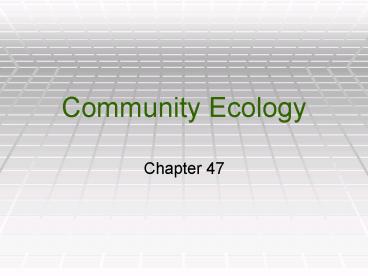Community Ecology - PowerPoint PPT Presentation
1 / 42
Title:
Community Ecology
Description:
A community is an assemblage of populations interacting with one another within ... Sea Anemone's Tentacles. Mader; Biology, 9th Ed. Mutualism ... – PowerPoint PPT presentation
Number of Views:4595
Avg rating:3.0/5.0
Title: Community Ecology
1
Community Ecology
- Chapter 47
2
Community Concept
- A community is an assemblage of populations
interacting with one another within the same
environment - Species composition is a listing of various
species in the community - Species diversity includes both species richness
and species diversity - Species richness number of species
- Species evenness number of individuals within
each population
3
Community
4
Diversity and Composition Models
- Gleason - Individualistic Model
- Each population in community is there because its
own particular abiotic requirements are met by a
particular habitat - Clements - Interactive Model
- Community is the highest level of organization
- Dependent on biotic interactions
5
Species Richness of Communities
6
Island Biogeography
- MacArthur and Wilson
- Developed a general model of island biogeography
- Explains and predicts how community diversity of
an island is affected by - Distance from the mainland
- Size of an island
7
Model of Island Biogeography
8
Community Structure
- Competition
- When two species compete for limited resources
the abundance of both species is negatively
impacted - Predation (or parasitism)
- Expected to increase the abundance of the
predator (or parasite) - And reduce the abundance of the prey and its host
9
Habitat and Ecological Niche
- Habitat
- The area an organism lives and reproduces in
- Ecological niche
- The role an organism plays in its community,
including - its habitat
- its interactions with other organisms
- Fundamental niche - All conditions under which
the organism can survive - Realized niche - Set of conditions under which it
exists in nature
10
Feeding Niches for Wading Birds
11
Competition Between Populations
- Interspecific competition
- When members of different species try to utilize
same resource - Resource in limited supply
- Competitive Exclusion Principle
- No two species can occupy the same niche at the
same time - Resource Partitioning decreases competition
- Can lead to character displacement
12
Competition between populations
13
Character Displacement
14
Niche Specialization
15
Competition Between Species
16
Predator-Prey Interactions
- Predation
- One living organism, the predator, feeds on
another, the prey - Predator is larger
- Predator has lower reproductive rate
- Prey usually entirely consumed
- Presence of predators can decrease prey
densities, and vice-versa
17
Paramecium caudatum and Didinium nasutum
interaction
18
Lynx-Snowshoe Hare Interactions
19
Prey Defenses
- Prey defenses are mechanisms that thwart the
possibility of being eaten by a predator - Spines
- Tough Epidermis
- Poisonous Chemicals
- Camouflage
- Bright Coloration
- Flocking Behavior
20
Camouflage in the Anglerfish
21
http//www.gdargaud.net/Antarctica/Penguins.htmlE
mperor
http//www.gotpetsonline.com/pictures-gallery/exot
ic-pictures-breeders-babies/hedgehog-pictures-bree
ders-babies/pictures/hedgehog-0009.jpg
http//animal.discovery.com/guides/reptiles/iguana
s/beardeddragon.html
22
Mimicry
- Mimicry occurs when one species resembles another
that possesses an overt antipredator defense - Batesian - Mimic lacks defense of the organism it
resembles - Müllerian - Mimic shares same protective defense
23
Batesian Mimicry
24
Müllerian Mimicry
25
Symbiotic Relationships
- Symbiosis refers to interactions in which there
is a close relationship between members of two
populations - Parasitism
- Parasite derives nourishment from a host, and may
use host as habitat and mode of transmission - Endoparasites
- Ectoparasites
26
Endoparasites
http//www.bbc.co.uk/schools/gcsebitesize/biology/
livingthingsenvironment/0habitatsandpopsrev7.shtml
www.drnatura.com/parasites.php
www.drnatura.com/parasites.php
27
Ectoparasites
www.springlodgevet.co.uk/illexternal.html
www.biology.utah.edu/bionews/louse384.jpg
www.bigpawsonly.com/dog-ticks-health.htm
28
Life Cycle of a Deer Tick
29
Commensalism
- Commensalism is a symbiotic relationship in which
one species is benefited and the other is neither
benefited nor harmed - Remoras and Sharks
- Many examples may turn out to be mutualism or
parasitism - Amount of harm or benefit two species do to one
another is partially determined by the
investigator
30
Clownfish AmongSea Anemones Tentacles
31
Mutualism
- Mutualism is a symbiotic relationship in which
both members of the association benefit - Often help organisms obtain food or avoid
predation - Bacteria in human intestinal tract
- Need not be equally beneficial to both species
- Cleaning Symbiosis
32
Mutualism Between Bullhorn Acacia and Ants
33
Cleaning Symbiosis
34
Community Development
- Ecological Succession
- A change involving a series of species
replacements in a community following a
disturbance - Primary Succession occurs in areas where there is
no soil formation - Secondary Succession begins in areas where soil
is present - Pioneer Species
35
Secondary Succession in a Forest
36
Succession Models
- Facilitation Model
- Each stage facilitates invasion and replacement
by organisms of the next stage - Climax Community
- Succession in a particular area will always lead
to the same type of community
37
Succession Models
- Inhibition Model
- Colonists hold onto their space and inhibit
growth of other plants until the colonists are
damaged or die - Tolerance Model
- Different types of plants can colonize an area
at the same time - Chance determine which seeds arrive first
38
Community Diversity
- Community stability can be recognized in three
ways - Persistence through time
- Resistance to change
- Recovery once a disturbance has occurred
39
Intermediate Disturbance Hypothesis
- Moderate amounts of disturbances at moderate
frequency are required for a high degree of
community diversity - If widespread disturbances occur frequently,
diversity will be limited
40
Intermediate Disturbance Hypothesis
41
Predation, Competition, and Biodiversity
- In certain communities, predation by a particular
species reduces competition and increases
diversity - Predators that regulate competition and maintain
community diversity are referred to as keystone
predators - Introduction of exotic species into a new area
may lead to unbridled competition and resultant
reduction in biodiversity
42
(No Transcript)































